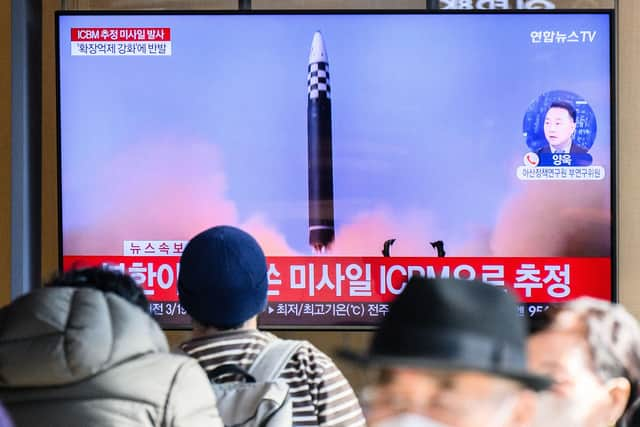What is an intercontinental ballistic missile? How powerful is nuclear weapon - does the UK have any missiles?
and live on Freeview channel 276
North Korea have confirmed they had flight-tested a solid-fuel intercontinental ballistic missile (ICBM) on Thursday 13 April. Named the Hwasong-18, state news channel Korean Central News Agency (KCNA) said the launch was supervised by leader Kim Jong Un.
ICBMs are powerful nuclear missiles that have a range of between 6,000 to 9,300 miles, making targets across the world vulnerable. First created by the Soviet Union in 1958 during the Cold War, they are considered a strategic defence weapon due to how deadly they can be.
Advertisement
Hide AdAdvertisement
Hide AdSouth Korea’s Defence Ministry have stated that North Korea do not have the technology to protect its ICBM missiles from atmospheric re-entry, however analysts have said the launch likely shows an advance in North Korea’s goal to build a nuclear arsenal.
So, what is an intercontinental ballistic missile, how powerful is it and does the UK have any? Here’s everything you need to know.
What is an intercontinental ballistic missile?
An ICBM is a land-based nuclear missile that was first developed by the Soviet Union during the Cold War in 1958. The United States (US) developed the missiles the following year in 1959, according to Britannica currently only three countries in the world have land-based missiles of this range which are Russia, US and China.


According to the US National Park Service ICBMs have a range of between 6,000 to 9,300 miles, potentially making international targets vulnerable. They are considered a strategic defence weapon due to how powerful and deadly they can be. There are many different types of ICBMs including the Atlas missile, Titus missile, Minuteman and Peacekeeper missile.
How powerful are they?
Advertisement
Hide AdAdvertisement
Hide AdICBMs are incredibly powerful and deadly and if used could cause widespread destruction due to explosions and subsequent radiation. According to Missile Defence Advocacy, an ICBM with an average of 3.6kg HE payload could cause an explosion damage radius of up to 1.47km. If this were to happen in an urban area, they have estimated there could cause over 180,000 casualties, depending on local populations.
Does the UK have any intercontinental ballistic missiles?
The UK does not have any ICBMs, however according to the Arms Control Association as of July 2019 it maintains a stockpile of 215 nuclear weapons and 120 warheads. The UK is actively working to reduce its cache of nuclear weapons and aims to reduce this number down to 180 by 2025, which would see a 65% reduction since the Cold War. Nuclear arsenal in the UK is also being modernised, with the Vanguard-class submarines which hold the weapons expected to be replaced by Dreadnought-class submarines in the 2030s.


What happened in North Korea?
North Korea has confirmed they have flight-tested the launch of a solid-fuel ICBM between the Korean Peninsula and Japan. The launch of the missile named Hwasong-18 was supervised by leader Kim Jong Un, with state media channel KCNA describing it as the most powerful weapon of his nuclear forces.
North Korea have tested a variety of intercontinental missiles since 2017, with 27 missiles being launched this year alone. However, what makes it different this time is that the latest ICBM uses solid-fuel, meaning it is easier to move and can fire quicker, making it harder to detect and intercept the launch.
Comment Guidelines
National World encourages reader discussion on our stories. User feedback, insights and back-and-forth exchanges add a rich layer of context to reporting. Please review our Community Guidelines before commenting.
